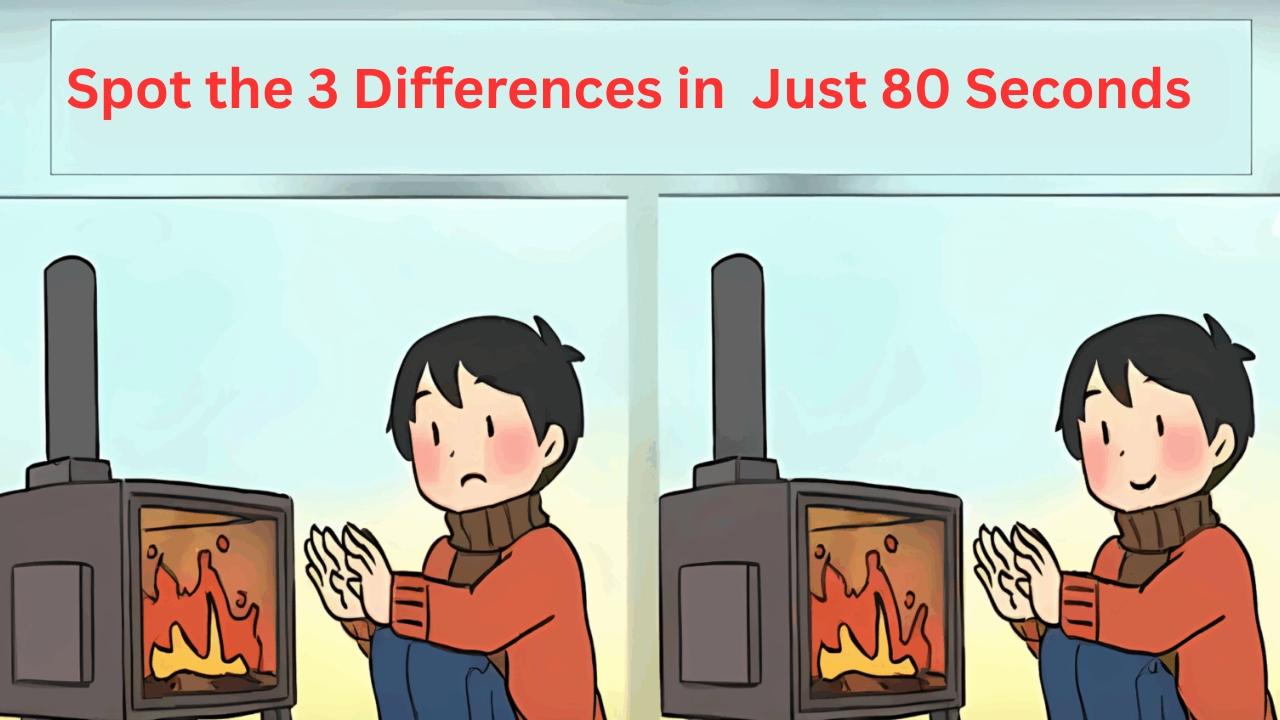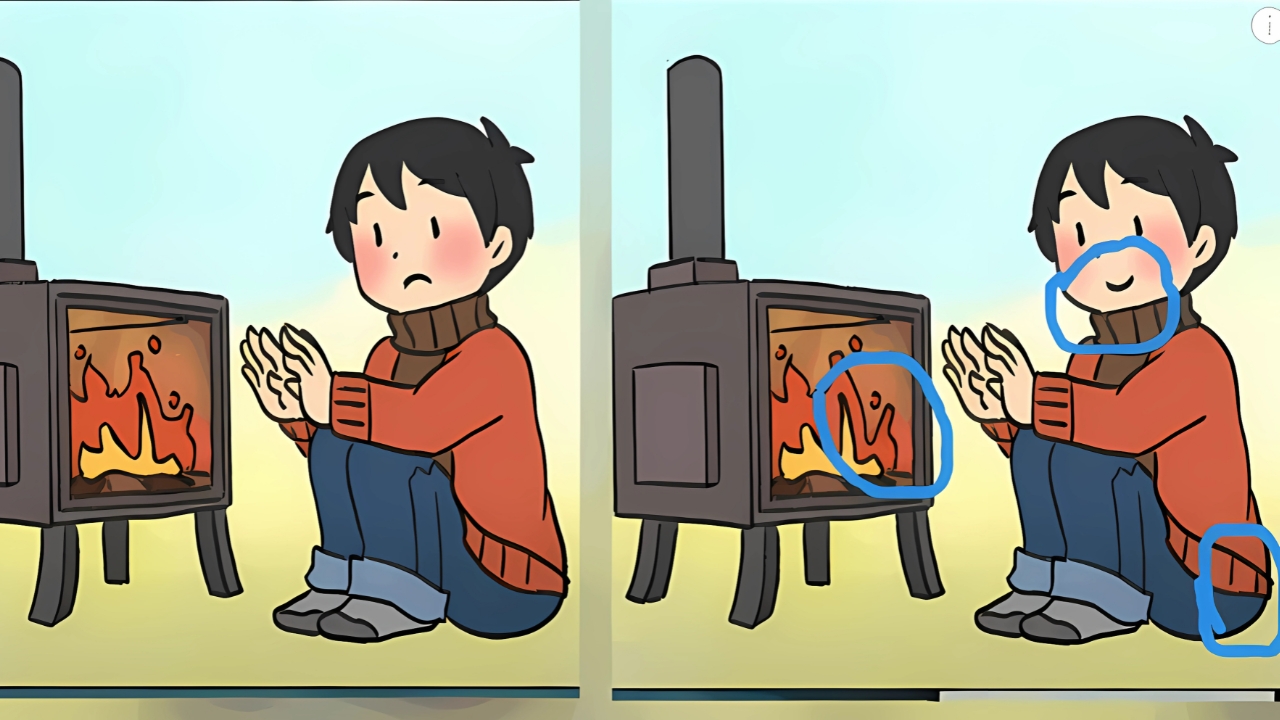Optical Illusion : Have you ever gazed at two seemingly identical photographs, your eyes dancing frantically between them as you search for hidden differences? These captivating visual puzzles represent far more than simple entertainment.
They serve as remarkable windows into the intricate workings of human cognition and offer valuable insights into how our brains process the complex visual world around us.
Understanding the mechanics behind these perception challenges reveals a fascinating intersection of neuroscience, psychology, and visual processing that affects virtually every aspect of our daily lives. When we engage with these puzzles, we activate sophisticated neural networks that have evolved over millions of years to help us navigate and interpret our environment.
The Neurological Foundation of Visual Perception
The human visual system operates as an incredibly sophisticated biological computer, processing approximately eleven million bits of information every second. When we encounter optical illusions or spot-the-difference challenges, this remarkable system faces unique obstacles that reveal both its strengths and limitations.
Consider how your brain processes visual information during these exercises. Light enters your eyes and strikes specialized cells called photoreceptors in the retina. These cells convert light into electrical signals that travel through the optic nerve to various regions of the brain, including the primary visual cortex. This initial processing stage handles basic elements like edges, colors, and movement patterns.
However, the real complexity emerges in subsequent processing stages where your brain attempts to make sense of this raw visual data. Higher-level visual areas work to identify objects, recognize patterns, and create the coherent visual experience we perceive as reality. Optical illusions exploit weaknesses in this sophisticated system, demonstrating how our brains sometimes make assumptions or fill in missing information based on past experiences and expectations.
The Science Behind Spot-the-Difference Challenges
When you engage with a spot-the-difference puzzle, your brain initiates a complex sequence of cognitive processes that researchers have studied extensively. Your visual attention system begins by rapidly scanning both images through quick eye movements called saccades. These movements, which occur three to four times per second, allow your eyes to gather detailed information from different areas of the visual field.
Simultaneously, your working memory system activates to hold multiple visual elements in conscious awareness while comparing them between images. This process taxes several cognitive resources simultaneously, making these challenges excellent exercises for mental flexibility and attention control. The difficulty arises because your brain must maintain detailed visual information about both images while actively searching for discrepancies.

Research in cognitive psychology has revealed that successful completion of these tasks requires coordination between multiple brain networks. The attentional network focuses your cognitive resources on relevant visual features, while the executive control network manages the systematic comparison process. Meanwhile, the visual processing network analyzes shapes, colors, textures, and spatial relationships to identify potential differences.
Time Pressure and Cognitive Performance
The addition of time constraints to visual perception challenges creates an entirely different psychological dynamic that affects performance in measurable ways. When faced with a ninety-second deadline to identify three hidden differences, your brain must balance speed against accuracy while managing the stress response that time pressure naturally creates.
This temporal element activates your sympathetic nervous system, releasing hormones like adrenaline that can either enhance or impair performance depending on individual differences and stress tolerance. Some people thrive under time pressure, experiencing heightened focus and accelerated processing speeds. Others find that deadlines create anxiety that interferes with their natural visual scanning abilities.
The optimal time limit for these challenges reflects careful research into human attention spans and visual processing capabilities. Ninety seconds provides sufficient time for thorough examination while maintaining enough pressure to create engagement and challenge. This duration typically allows most people to find at least one or two differences while making the discovery of all three achievable but not guaranteed.
Strategic Approaches to Visual Puzzle Solving
Developing effective strategies for these challenges involves understanding how attention and visual processing work most efficiently. Rather than relying on random scanning, successful puzzle solvers typically employ systematic approaches that maximize their chances of success within time constraints.
The quadrant method represents one of the most effective techniques, involving mental division of each image into four sections for methodical comparison. This approach prevents the common mistake of repeatedly examining the same areas while neglecting others. By systematically working through each quadrant, solvers ensure comprehensive coverage of both images.
Another valuable technique involves adjusting your focus strategy. Direct, concentrated attention works well for obvious differences but can cause you to miss subtle changes that your peripheral vision might detect more easily. Alternating between focused examination and relaxed scanning often yields the best results, allowing different visual processing mechanisms to contribute to the search process.
Experienced puzzle enthusiasts often begin their search with high-interest areas like faces, text, or central objects, as puzzle creators frequently place modifications in these locations. However, they balance this approach with attention to background elements, borders, and seemingly insignificant details where subtle changes might hide.
Cognitive Benefits Beyond Entertainment
Regular engagement with visual perception challenges offers measurable cognitive benefits that extend far beyond simple entertainment value. These exercises function as targeted workouts for specific brain regions involved in attention, visual processing, and executive control. Like physical exercise strengthens muscles, consistent practice with these mental challenges can enhance cognitive capabilities.
Studies in neuroplasticity demonstrate that adults who regularly engage with visual attention tasks show improvements in sustained attention, visual discrimination abilities, and processing speed. These enhancements transfer to real-world activities requiring careful observation, such as driving, reading, and professional tasks that demand attention to detail.
For children, these benefits prove particularly significant during critical developmental periods when visual processing systems are still maturing. Regular exposure to age-appropriate visual challenges supports the development of attention control, patience, and systematic problem-solving approaches that benefit academic performance across multiple subjects.
Individual Differences in Visual Perception
Understanding why some people excel at these challenges while others struggle requires examining the various factors that influence visual perception abilities. Genetic differences in visual processing speed, working memory capacity, and attention control all contribute to performance variations between individuals.
Age represents another significant factor, though not always in expected ways. While processing speed typically peaks in early adulthood, older adults often compensate through superior strategy use and accumulated experience with visual patterns. Children may struggle with systematic approaches but often demonstrate remarkable ability to notice unexpected details that adults overlook.
Personality traits also influence performance in interesting ways. Individuals with detail-oriented personalities often excel at spotting subtle differences but may struggle with time pressure. Conversely, those comfortable with quick decision-making might identify obvious changes rapidly but miss more subtle modifications.
The Role of Expectation and Pattern Recognition
One of the most fascinating aspects of these visual challenges involves how our expectations and past experiences influence what we see. The human brain constantly generates predictions about upcoming visual information based on context and previous experience. This predictive processing system, while usually helpful, can work against us in spot-the-difference challenges.
When examining familiar scenes or objects, your brain automatically fills in expected details, sometimes preventing you from noticing when those details have been altered. This phenomenon explains why differences involving unexpected changes often prove most difficult to detect. Your visual system processes the scene according to its predictions rather than carefully examining every detail.
Understanding this limitation allows for more effective puzzle-solving strategies. Deliberately questioning your assumptions about what you expect to see can help overcome the brain’s tendency toward predictive processing. This meta-cognitive awareness transforms the challenge from a simple visual task into an exercise in critical thinking and self-awareness.
Cultural and Educational Applications
Visual perception challenges have found applications across diverse cultural and educational contexts, reflecting their universal appeal and proven effectiveness for cognitive development. Educators worldwide incorporate these activities into curricula ranging from early childhood development to adult continuing education programs.
In therapeutic settings, occupational therapists use adapted versions of these challenges to help individuals recovering from brain injuries rebuild visual processing capabilities. The scalable difficulty and objective scoring make them valuable tools for tracking recovery progress and identifying areas needing focused intervention.
Corporate training programs increasingly include visual perception exercises to enhance employee attention to detail and observation skills. Fields requiring high levels of visual accuracy, such as quality control, medical diagnosis, and security screening, benefit particularly from this type of training.
Optical Illusion Answer

Technology and the Future of Visual Challenges
Digital technology has revolutionized the creation and distribution of visual perception challenges, enabling sophisticated variations that would be impossible with traditional static images. Computer-generated puzzles can incorporate animated elements, three-dimensional perspectives, and adaptive difficulty levels that respond to individual performance.
Virtual and augmented reality platforms offer exciting possibilities for immersive visual challenges that engage spatial reasoning and depth perception in addition to traditional two-dimensional scanning skills. These emerging technologies may provide even more effective tools for cognitive training and assessment.
Artificial intelligence systems now assist in creating optimally challenging puzzles by analyzing human performance patterns and adjusting difficulty levels accordingly. This technological integration promises more personalized and effective training experiences tailored to individual cognitive profiles and learning objectives.
Building Your Visual Perception Skills
Developing expertise in visual perception challenges requires consistent practice combined with deliberate attention to strategy refinement. Like any complex skill, improvement comes through focused effort rather than casual engagement. Setting specific goals, tracking performance over time, and systematically working on areas of weakness accelerates skill development.
Varying the types of visual challenges you encounter prevents your brain from becoming too specialized in one particular format. Different puzzle styles exercise different aspects of visual processing, creating more comprehensive cognitive benefits than repetitive practice with identical challenge types.
Most importantly, approaching these exercises with curiosity and patience rather than frustration maximizes both enjoyment and learning outcomes. The goal extends beyond simply finding differences quickly to developing deeper understanding of how your own visual perception system operates and how it can be enhanced through deliberate practice.
These remarkable puzzles offer us a unique opportunity to explore the fascinating intersection of neuroscience, psychology, and everyday cognition while providing practical benefits that enhance our daily lives. Whether you excel immediately or require practice to improve, engaging with these challenges connects you to fundamental questions about human perception and the remarkable capabilities of the mind.
